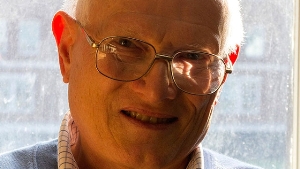May 26 2014
JQI fellow Paul Julienne has recently retired from NIST but continues to perform high-level theoretical research in the subject he helped to create---ultracold matter. In honor of his birthday, a meeting called Frontiers of Cold Matter is being held May 29-30 at JQI.
 Paul Juliene
Paul Juliene
JQI co-director Charles Clark had this to say: "JQI has an amazing scientific team, and Paul Julienne stands out in it as the greatest master of his difficult craft - the theory of ultracold atomic collisions. There seems to be no one else in the world who competes at the same level as Paul in that game. Indeed there are few people in ANY competitive game that dominate it as Paul does his."
Professor Sir Keith Burnett of the University of Sheffield also comments: “Paul's influence on science has been enormous. His theoretical insights and computational methods for atomic and molecular collisions, from ultracold interactions to encounters in laser or magnetic fields, cover an extraordinary range of cutting edge physics. I cannot imagine the field of ultracold interactions without Paul Julienne. He does it all: thinks of important novel experiments, devises ways to analyze the results, and goes on to bring out new physics and insights. What is more, he keeps innovating and driving the conceptual frontier of his field. I have been deeply privileged to work with Paul Julienne, and his help and support in my early career was invaluable. My discussions with him over the years have always left me knowing I had talked with someone with a deep love for and grasp of science. He is revered by his colleagues who often become dear friends. He is the most perfect of colleagues, deeply courteous and unfailingly supportive of those he works with.”
Here is how Paul Julienne describes his own research. “My general area of interest has been in theoretical molecular spectroscopy and atomic collision processes, in particular, in the application of theoretical techniques to obtain a better understanding of basic atomic and molecular phenomena. Most of this work has been directed at understanding experimental observations or to make predictions that can be tested by new experiments. Work in the 1970’s involved applications to atmospheric and astrophysical problems. From the late 1970s through the 1980s, applications centered on issues relating to the development of high-energy lasers and collisions in light fields. For the last 25 years, since the development of laser cooling in the mid 1980s by Bill Phillips at NIST and other groups elsewhere, I have concentrated on phenomena associated with cold trapped atoms or molecules. Current research is directed in two areas. The first is the formation and control of ultracold molecules. This includes the development of simplified quantitative models for understanding and calculating the properties of magnetically tunable Feshbach resonances, which have been very successfully used to make cold molecules and to control atom interactions in quantum degenerate atomic gases or optical lattices. The molecular research also includes understanding the chemical reaction rates of ultracold molecules and the exotic trimer states of three cold atoms. The second area involves the study of closed shell S-state atoms such as Ca, Sr, and Yb. These species can be laser cooled, have both bosonic and fermionic isotopes, and have good prospects for use in ultraprecise optical clocks, as new kinds of quantum degenerate gases or lattices, or for quantum information applications.”
Paul Julienne is a graduate of Wofford College (1965) and received Ph.D. (1969) in chemical physics from the University of North Carolina at Chapel Hill. He worked at the Naval Research Laboratory from1971 to 1974. But most of his career has been at NIST (or NBS as it used to be called), first as a NRC postdoctoral research associate (1969-1971) with Frederick H. Mies, as staff member (1974-1995), as Group Leader of the Quantum Processes Group, Atomic Physics Division (1995-2003), as a fellow at Joint Quantum Institute (2007-2013, and as emeritus fellow as of 2013), and as a NIST fellow (2003-2013).
He has over 230 publications to his name; his papers have received more than 1000 citations per year since 2011, and he has an “h-index” of 54 through the year 2013. Here are his most recent publications: P. S. Julienne, “Chaos in the Cold,” Nature 507, 440-441 (2014), News and Views (JQI press release); Caroline L. Blackley, P. S. Julienne, and Jeremy M. Hutson, “Effective-range approximations for resonant scattering of cold atoms,” Phys. Rev. A 89, 042701 (2014) (an Editor's Suggestion article); and P. S. Julienne and J. M. Hutson, “Contrasting the wide resonances in 6Li and 7Li,” to appear in Phys. Rev. A 89, 052715 (2014); Yujun Wang and P. S. Julienne, “Universal van der Waals Physics for Three Ultracold Atoms,” arXiv:1404.0483.
Honors received include the Department of Commerce Silver Medal (1992) and Gold Medal (1998); the 2004 Davisson-Germer Prize of the American Physical Society (Citation: “For his pioneering studies of the theory of ultracold atomic collisions, and its applications to precision metrology and quantum gas dynamics”); the 2004 NIST Samuel Wesley Stratton Award for outstanding scientific or engineering achievements in support of NIST objectives (Citation: “For world leading theoretical physics research in collisions fundamental to the laser cooling of atoms and Bose-Einstein condensation”); 2005, Washington Academy of Sciences Annual Award for Work of Merit and Distinction in the Physical Sciences (Citation: “For pioneering studies of the theory of ultracold atomic collisions and its numerous applications that continue to impact forefront research from Bose-Einstein condensation to atomic clocks”); 2007, Meritorious Presidential Rank Award (these awards recognize exceptional long-term accomplishments in public service by career senior government executives or scientists. Award winners are nominated by their agency heads, evaluated by boards of private citizens, and approved by the President.)